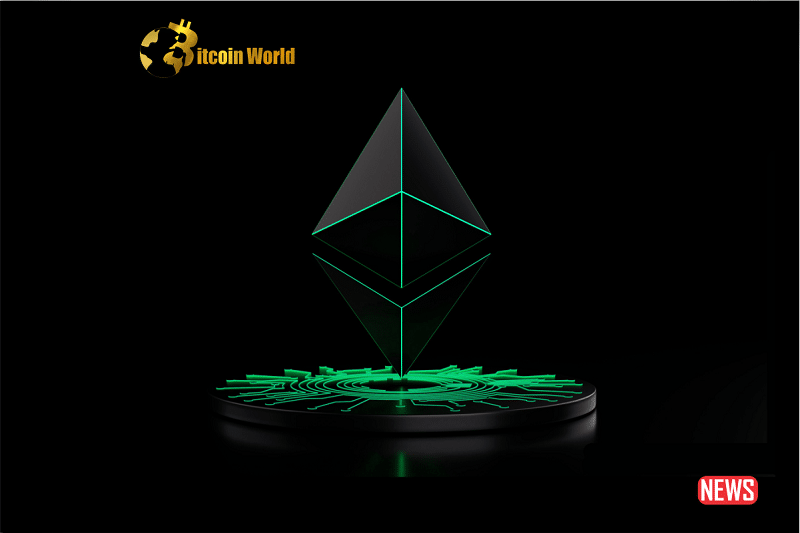The world of decentralized finance (DeFi) is constantly evolving, with projects experiencing both meteoric rises and concerning falls. Recently, a spotlight has been cast on EthereumPoW, and unfortunately, the news isn’t good. The platform’s DeFi ecosystem is facing significant headwinds, marked by a dramatic drop in its Total Value Locked (TVL). Let’s dive into the details and understand what’s driving this downward trend.
EthereumPoW’s DeFi TVL: A Deep Dive into the Decline
Imagine a vibrant marketplace suddenly losing its appeal. That’s somewhat analogous to what’s happening with EthereumPoW’s DeFi. Data from DefiLlama paints a stark picture: a staggering 97% decrease in TVL since the network’s inception just nine months ago. That’s a significant shift! While the initial launch in September 2022 saw a surge, peaking at $6.78 million in late October, the momentum couldn’t be sustained. This year alone has witnessed a 76% decline. What are the key factors contributing to this worrying trend?
- Significant TVL Drop: A 97% decrease since launch signals a major outflow of assets from the platform’s DeFi protocols.
- Consistent Downtrend: The decline isn’t a sudden blip but a persistent trend, indicating deeper underlying issues.
- Poor Performance in 2023: A 76% drop this year highlights the accelerating nature of the problem.
LFGSwap: Even the Leading Project Feels the Pinch
To get a clearer picture, let’s look at the leading DeFi project on EthereumPoW, LFGSwap. While it currently holds the largest share of the network’s TVL at $95,040, even this project hasn’t been immune to the downturn. Since November 2022, LFGSwap has experienced a 96% decrease in its TVL. This demonstrates that the challenges are widespread across the ecosystem.
Furthermore, the data reveals that the majority of protocols on the chain are struggling. In the past week alone, eight out of fifteen protocols experienced TVL drops, with one seeing a dramatic 85% decrease. This widespread decline raises serious questions about the overall health and attractiveness of the EthereumPoW DeFi landscape.
Mining Activity: Is the Engine Sputtering?
The health of a Proof-of-Work blockchain like EthereumPoW is closely tied to its mining activity. So, what do the mining metrics tell us? Unfortunately, the news here isn’t encouraging either. Data from 2Miners.com shows a concerning steady fall in EthereumPoW’s hash rate. Currently at 11.06TH/s, the hash rate has decreased by 33% since the beginning of the year and a massive 83% since September 2022. This significant drop suggests a dwindling number of miners supporting the network.
As expected, the reduced mining activity has led to a corresponding decrease in the chain’s mining difficulty. The current network difficulty stands at 147.47T, representing an 82% decrease since the Ethereum Merge in September 2022, which saw the original Ethereum transition to a Proof-of-Stake consensus mechanism.
| Metric | Current Value | Change Since Jan 2023 | Change Since Sep 2022 |
|---|---|---|---|
| TVL | Data Dependent | -76% | -97% |
| Hash Rate | 11.06 TH/s | -33% | -83% |
| Mining Difficulty | 147.47T | Data Dependent | -82% |
Why Are Miners Leaving?
A decrease in hash rate and mining difficulty typically points to a reduction in the number of miners actively participating in the network. Several factors can contribute to this:
- Decreasing Mining Rewards: As the value of the mined cryptocurrency (ETHW) falls, the profitability of mining diminishes, making it less attractive for miners.
- Fall in Cryptocurrency Value: The price of ETHW directly impacts the economic viability of mining operations.
- Increased Costs: Electricity and hardware costs remain constant, squeezing profit margins when rewards decrease.
- Alternative Opportunities: Miners might find more profitable opportunities mining other cryptocurrencies.
A Glimmer of Hope? New Addresses on the Rise
Amidst the concerning trends, there’s a curious piece of data. EthereumPoW has witnessed a surge in new addresses in the past 24 hours. According to OKLink data, a significant 426,681 new addresses were created, bringing the total number of addresses to a substantial 351 million. However, it’s crucial to note that less than 1% of these addresses were active during the same period. This raises questions about the nature of these new addresses – are they genuine users, or could there be other factors at play?
ETHW’s Performance: Mirroring the Network’s Struggles
The native coin of the EthereumPoW network, ETHW, is also reflecting the challenges faced by the platform. Currently trading at $2.02, ETHW has experienced a 2% price drop and a significant 33% decrease in trading volume in the last 24 hours. This correlation between the network’s performance and its native token’s value underscores the interconnectedness of the ecosystem.
The Road Ahead: Can EthereumPoW Rebound?
EthereumPoW finds itself at a critical juncture. The significant drop in DeFi TVL, coupled with declining mining activity and trade volume, presents a serious challenge. The future of the platform hinges on the EthereumPoW community’s ability to address the underlying issues driving this downward trend.
What steps can be taken?
- Community Engagement: Open discussions and collaborative problem-solving are crucial.
- Strategic Decision-Making: Careful consideration of potential solutions and their impact is essential.
- Innovation and Development: Exploring new features and improvements to attract users and developers.
- Marketing and Outreach: Communicating the platform’s value proposition and addressing concerns.
The path to recovery won’t be easy, but by working together and making strategic decisions, EthereumPoW has the potential to reclaim its position as a viable blockchain platform for decentralized finance. The coming months will be crucial in determining whether the network can overcome its current challenges and forge a sustainable future.
Disclaimer: The information provided is not trading advice, Bitcoinworld.co.in holds no liability for any investments made based on the information provided on this page. We strongly recommend independent research and/or consultation with a qualified professional before making any investment decisions.


